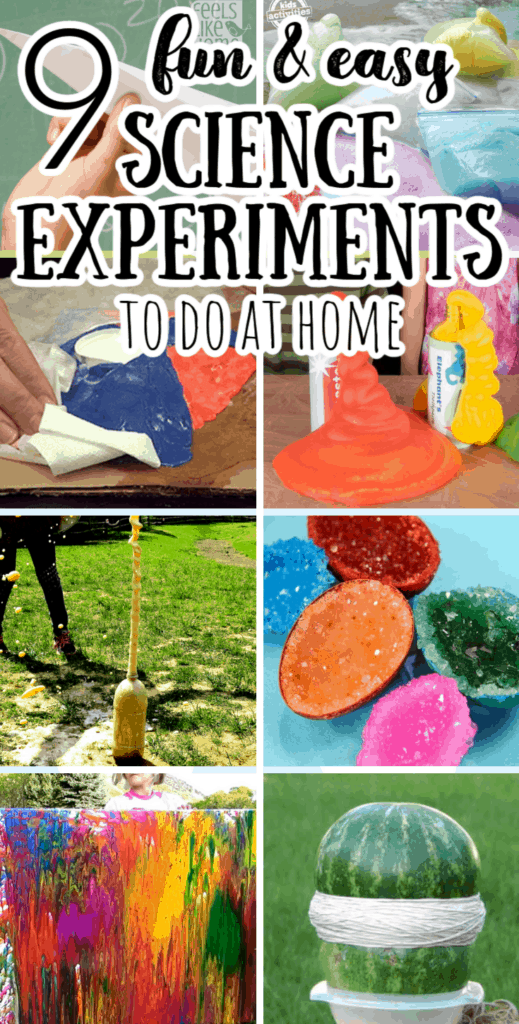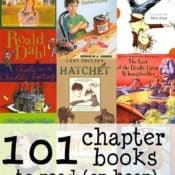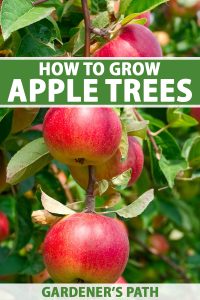9 Easy Science Experiments to Do at Home
These 9 fun science experiments for kids and parents are easy to do at home without special materials and make messy memories!


These 9 fun science experiments for kids and parents are easy to do at home without special materials and make messy memories that your kids will not soon forget!


When kids are having fun, they learn better. Think about it, would you rather learn to crochet using a printed pattern or from a YouTube video? The more hands-on and engaging, the better!
I think science experiments get a bad reputation because they’re messy and require materials. I know, it can be a drag.
But seriously, your kids will talk forever about all the cool things you’ve done, and they will remember the science behind the activities.
I speak from personal experience here. I have a master’s degree in teaching and spent 10 years as a high school science teacher. I have a lot of respect for hands-on science, having seen it in action over and over again.
Easy explanations & easy experiments
Science is not hard.
Well, maybe quantum mechanics is hard. But elementary science, the kid-friendly kind that you can do at home, is not difficult.
Maybe you’ve not found the right explanation or the right inspiration, but I promise you that any parent can handle some fun science experiments, even if they themselves were horrible at science in school.
You don’t have to be a scientist to make it work at home. Just do something interesting. Your kids will not be able to resist, and they will join in.
Easy Science Experiments to Do at Home


Crystal egg geodes
This tutorial and science lesson was featured on Buzzfeed a few years ago as the #1 kids’ science experiment that adults will enjoy. It is simple – you just make an alum solution (you’ll have to order that online, but it is cheap and safe to handle), seed the eggs with dry crystals, and then wait. Your kids will LOVE seeing the crystals develop.


Paper airplane experiment
This experiment is awesome because it is 100% kid driven. Your kids will write their own question and design their own paper airplane project. Bonus – this requires virtually no materials, only some different kinds of papers and possibly some paper clips, staples, and tape.


Elephant toothpaste
This fun science experiment creates a foaming mess that is a shining example of a chemical reaction using everyday items you have in your home like hydrogen peroxide, dry yeast, dish soap, and food coloring. The best part of this experiment is that you can play with the ratios and containers to see how you can get a larger foam reaction. It’s a perfectly safe project for your children to do, though you may want to get some safety glasses to keep the foam out of sensitive eyes.


Mentos and coke
This simple and messy science experiment is on every kid’s to-do list. They have all seen it done on TV or in YouTube videos, and they are just itching to try it in person. Trust me on this.
Make their day by bringing home these two simple ingredients (Diet Coke and original Mentos – a few bottles and packages of each) and let them give this a try. They’ll know what to do.
If you don’t know, it is super simple. All you do is place the Diet Coke (it has to be Diet Coke, nothing else) in the middle of an area that can get messy. Take the lid off. Then, drop a handful of Mentos in and get back ASAP. A huge geyser of Diet Coke will instantly shoot upwards, as much as ten feet or more. You can play around with how many Mentos you put in and you can also re-use the same bottle of Diet Coke a couple of times. (But it will eventually stop working which is why I recommend buying a few bottles. One is not enough!)
This one is going to become a sugary mess (so maybe take it outside) but it is well worth it to see your kids’ excitement and to use it as an opportunity to discuss chemical reactions.


Baking soda volcanoes
Always wanted to do a homemade volcano with the kids? This is a fun project you can do as part of your geography lessons. While you can use a kit to build your volcano, the site I linked (made by NASA) gives instructions on building a volcano from PlayDoh.
The fun thing about the baking soda reaction is that it breaks down something smelly and kind of gross (straight vinegar) into plain old water. I’m not saying you should drink it (although you could; there’s nothing harmful in it), but it is fun to explain to the kids that baking soda plus vinegar reacts to make plain water and carbon dioxide (which is the air you breathe out and is also what makes the bubbles in fizzy drinks).
Also, the NASA article doesn’t say this, but if you want the maximum foam factor, you can add a few squirts of dish soap to the vinegar and mix it up before you add the baking soda. Try it and see what happens!


Water bottle rockets
Most of us have memories of making rockets out of two-liter bottles and taking them outside to set them off. This experiment can get really fun and is a great way to teach your children hands-on how small changes made to their rockets will make them easier or harder to launch. You will need a launcher base, a bicycle pump, several empty 2-liter bottles, and simple art supplies like poster board and duct tape. You can also get all sorts of accessories like fins, parachutes, and more.


Water balloon painting
Ever wonder what a water balloon really looks like when it explodes? It happens so fast and everyone is running around you don’t really get a clear look at what the explosion looks like or what patterns that it makes. You can change that with some non-toxic paints and an old white flat sheet or a large canvas. Fill the water balloons with paint and place the sheet out where everyone can toss their balloons. When you are done, you will have a fun mural made from your messy science and have had a great first-hand view of how liquid flows when a balloon pops.


Exploding baggies (or film canisters or water bottles)
This classic is perfect for taking outside with the kids. All you need is ziplock bags, paper towels, corn starch, vinegar, baking soda, and food coloring. Combine 1 cup of cornstarch and 1 cup of vinegar in a ziplock bag. Add in your food coloring and mix well. Fold 2 tablespoons baking soda into a paper towel to make the activator for your experiment. When you are ready, drop the baking soda activator into the bag and seal as quickly as possible. Place the bag on your sidewalk or driveway and allow it to expand and pop open in front of your eyes. The explosion will leave behind a fun chalk-like print that will wash away in the next rain.
You can do something very similar with film canisters and empty disposable water bottles.
Also, you can experiment with different amounts of vinegar, cornstarch, and baking soda. One of Grace’s favorite “experiments” (I use that term loosely since she knows exactly what’s going to happen.) is to fill an empty water bottle half full with vinegar, then drop a sachet of baking soda in and close the lid. She shakes the bottle, waiting until it is really hard from the gas being release, and then she throws in at the driveway as hard as she can. It explodes in a blaze of glory. (Maybe don’t tell your younger kids about that because it’s a little dangerous, plastic shrapnel and all.)


Exploding watermelon
This summer science experiment is lots of fun and can make a huge mess.
Grab a watermelon and a big bag of rubber bands (at least 300, maybe more). Have your kids wear safety glasses to protect their eyes when things go flying. (This is also a good time to wear bathing suits for easy cleanup.)
Add rubber bands around the watermelon watching them squeeze it more and more until suddenly the entire thing pops sending watermelon flying. For a great observation activity, place a large piece of the watermelon in your backyard for a day or two to allow bees and butterflies to use it as food.
Science can be fun – and messy. But that’s part of the allure for our kids, I think.
Any time you can get your kids’ hands dirty and in the experiment, you’re going to have a winning project that they will learn so much from.










